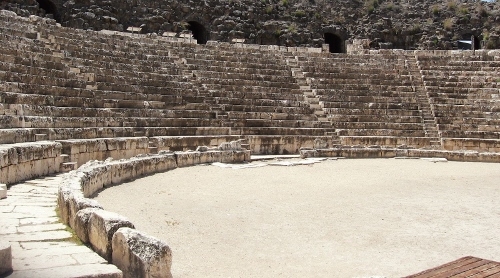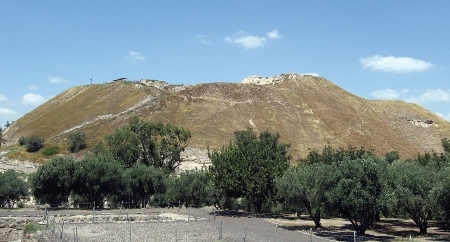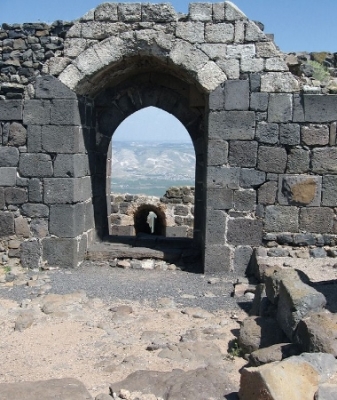Idle Thoughts at Bet She'an
I used to have a weird recurring dream. Back when I was a teenager, my parents and I lived in a house with a long upstairs corridor, with doors leading to bedrooms, a bathroom and a cozy little den. The corridor ended at a blank wall which was part of the exterior wall of the house. In my recurring dream however, I would float silently down the corridor until I came not to the blank wall that existed in reality, but instead to another door. I would pause at the door, staring at it with a mixture of surprise and amusement. I would then open the door slowly and find myself staring down the lengthy expanse of yet another corridor. Venturing down this newly discovered corridor, I would find doors opening onto unexpected new rooms, all fully furnished, and filled with fascinating curios, interesting artworks, lots of books and even expensive stereo equipment with hundreds upon hundreds of fabulous record albums, mostly jazz and blues. And throughout this strange dream, I would be made to understand that all of this wonderful stuff – the antique furniture, the exquisite artwork, as well as the fabulous books and records – apparently somehow belonged to me.
Lately, I've been getting another persistent dream – I had it again last night – in which I visit some place I haven't been to in many years. It is usually someone's house more often than not, the home of a long-deceased aunt. As I wander around, I discover hundreds of rare valuable books stashed in every nook and cranny of the house – on shelves, in cabinets, piled up in corners – books that I am made to understand belong, somehow, to me. A dream-narrator, speaking inside my head, informs me that these are books that I owned years ago, in high school, in college or somewhere, that went astray during my numerous moves and changes of address, and that I simply forgot about.
I had completely forgotten that I had ever owned them but – lo and behold – here they were, and all mine.
I can't afford psychoanalysis, so I've figured out these dreams myself. They both betray a common pattern: they are both about wonderful things that are mine, that have always been mine, and that I was unaware I owned or had forgotten I once possessed. And at this very moment, as I scribble these words into a frayed little shirt pocket-sized notebook, these two recurring dreams make perfect sense. I am sitting on a fragment of a 2,000 year old white marble pillar in the Roman ruins at Bet She'an. The helpful little brochure provided by the Israel National Parks Authority informs me that I am reposing near the entrance to the Roman temple constructed during the 2nd century C.E. A short distance in front of me, at the end of a broad Byzantine period agora - literally cluttered with pillars, porticoes and mosaic tile floors – is perhaps the best preserved Roman amphitheater in Israel with seating for 7,000. Not far from that are the ruins of a bath house, with hot and cool bathing areas and a hypocaust for heating water - built and used almost 2,000 years ago. There are also the remains of broad colonnaded streets (my high school Latin teacher would be thrilled that I can still remember the difference between Doric, Ionic and Corinthian columns), temples, fountains, pools and public lavatories. And right behind me, rising above the Roman and Byzantine city, is the imposing Tel Bet Sha'an, in which lie buried more than 20 levels of ancient settlement, from the Neolithic or New Stone Age through the Bronze Age and conquest by Ancient Egypt to the Iron Age Canaanite cities unsuccessfully besieged by the Israelite tribes and later conquered by King David.
For the first time visitor, Bet She'an is an unexpected treasure; 400 acres of fascinating and important archeological remains representing more than 4,000 years of Neolithic, Bronze Age, Canaanite, Egyptian, Israelite, Greek, Roman and Byzantine history. And all of it, every inch of it, is mine. That's right, every pool, pillar and paving stone – right down to the last mosaic tile – is completely, totally mine. Well, actually, it is ours. Like the things I find in my recurring dreams, Bet She'an is something that once belonged to us, the people of Eretz Yisrael, and later – through centuries of exile and dispersion – became something we simply forgot we had owned. And now that we have returned, it is time for all of us to rediscover the treasures that once belonged to us and are now ours again.
A scant 10 miles north of Bet She'an is Belvoir fortress, a 12th century Crusader redoubt, built by the Hospitallers or Knights of St. John in 1173. Commanding a spectacular view of the Jordan Valley, 1800 feet below, Belvoir ("good view") was the only Crusader fortress that refused to yield to the Muslims after the Crusader armies were defeated by the Arabs under Saladin at the Horns of Hittin, west of Tiberius, in 1187.
While most of the Crusaders retreated to Tyre in Lebanon, or returned to Europe, Belvoir continued to hold firm, resisting an 18 month siege – with occasional sorties to attack the Arab besiegers outside the fortress before finally accepting a truce in exchange for a safe passage. The Belvoir defenders yielded the fortress to Saladin and withdrew to Tyre, with their flags flying and banners waving.
Much of the fortress still stands – moat, walls, parapets and Gothic arches and it too is all ours. Yet while most of our people may have remembered Jerusalem throughout the 20 centuries of our exile, we seem to have forgotten Bet She'an and Belvoir. As I sit on this piece of a Roman column jotting these words into my notebook, there are no more than a handful of people here. Earlier today at Belvoir, my wife and I wondered through the ruins completely alone.
We were also surprised to find ourselves alone a few months ago at Apollonia, a small but breathtaking historical site no farther away that Herzliya. Perched on sandstone cliffs overlooking the sun-dappled blue water of the Mediterranean Sea below, Apollonia was, in turn, Phoenician, Israelite, Greek, Roman, Byzantine, Muslim, Crusader and then Muslim again, before being abandoned to the winds, weeds and spreading sands. Visitors can see the remains of the walled city, one or two Roman villas and the Crusader fortress, some of the walls of which still cling precariously to the cliffs above the ocean.
Well known to local historians and archeologists, Apollonia remains beyond the ken of most Israelis. Our Raanana taxi driver, for example, had never heard of the place and managed to get lost no fewer than three times before finally getting us there.
Encouragingly, however, he drove away with a National Parks Authority brochure of the site and a vow to return with his family.
Would everyone who has visited Masada please raise your hands? Very good.
Now, how many of you have been to Herodion? Ah-hah! Every bit as spectacular as Masada, Herodion was one of the major building projects of our builder-king, Herod the Great, described in great detail by the ancient Jewish historian Josephus. Constructed high on an artificial cone-shaped mountain some 9 miles south of Jerusalem, the immense Herodion complex was Herod's fortress, summer palace, district capital and later his burial place and monument. Following Herod's death and the banishment of his son Archeleus, Herodion was appropriated by the Romans for the enjoyment of a series of Roman governors until Jewish rebels took it away from them by force at the start of the revolt against Rome in 66 C.E. The Zealots built a synagogue and ritual bath at the site and held it as a fortress for four years before finally being defeated by the Romans. Abandoned until 132 C.E. Herodion was reoccupied by a later generation of Jewish rebels fighting Rome in the Bar Kochba revolt. Following their defeat after a long Roman siege, Herodion was again abandoned, this time for 500 years, until Byzantine monks took up residence among the ruins for more than two centuries. Abandoned one last time during the Arab conquest, Herodion remained deserted and largely forgotten until recent times. Even those completely uninterested in history will find that a visit to this site, extensively excavated by the National Parks authority, is unforgettable.
Our country is dotted with places like these, some like Jerusalem's Western Wall Tunnels much better known than others off the beaten track. Among my personal favorites are the excavations at Hazor and Megiddo, the Roman baths and amphitheater at Hamat Gader, and the underground chambers at Akko's Crusader fortress. Hundreds of others await me, my tattered little notebook and my nice new digital camera.
We live in a land of wonders and marvels. Go and enjoy them.











Comments